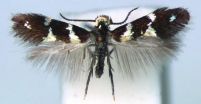(Press-News.org) When one fish gets injured, the rest of the school takes off in fear, tipped off by a mysterious substance known as "Schreckstoff" (meaning "scary stuff" in German). Now, researchers reporting online on February 23 in the Cell Press journal Current Biology have figured out what that scary stuff is really made of.
Within that chemical brew is a special type of sugar found in abundance in fish skin. When a fish is wounded, fragments of the sugar known as chondroitin sulfate alarm other fish nearby.
"Our results provide a solution to a 70-year-old puzzle: the nature of this alarm signal," says Suresh Jesuthasan of A*Star's Neuroscience Research Partnership and the Duke/National University of Singapore Graduate Medical School in Singapore.
Chondroitin sulfate is a major component of fish skin, he said, and its breakdown—likely triggered by enzymes released upon injury—seems to be the key.
The new study shows that Schreckstoff and these sugar fragments register in a particular part of the zebrafish brain. That region in the scent-processing olfactory bulb includes an enigmatic class of sensory neurons known as crypt cells.
The researchers suggest that those neurons may be specialized to detect the sugary alarm cue. "This region of the olfactory bulb has unique projections to higher centers of the brain," Jesuthasan says, "so there may be a special circuit mediating aspects of the innate fear response."
The findings identify a new class of odorants for fish. It also helps to explain how this "danger" signal might have evolved even though the signal offers no particular benefit to its sender. Those sugar fragments are naturally released upon injury, whether anyone can smell them or not. Fish able to pick up the scent and flee are more likely to survive and reproduce.
Puzzles remain, however. For instance, some fish species will sense alarm cues released from closely related species but respond less intensely to cues from more distant relatives. The trend suggests that chondroitin fragments may come in a variety of "flavors," and the researchers are now interested in testing whether the same fragments that breed fear in zebrafish will elicit responses in other species as well.
Ultimately, the discovery could lead to new insight into the nature of fear itself.
"These findings underscore the usefulness of the zebrafish as a system to investigate the neural basis of innate fear," Jesuthasan said. "Given the transparency of larval fish, it is possible to see at single-cell resolution what happens throughout the brain when the organism detects danger. This will allow us in the future to ask how neurons, as a group, regulate behavior and emotional responses."
INFORMATION: END
LA JOLLA, Calif., February 23, 2012 – Researchers at Sanford-Burnham Medical Research Institute (Sanford-Burnham) and the Medical School of Hannover in Germany recently discovered how the botulinum neurotoxin, a potential bioterrorism agent, survives the hostile environment in the stomach on its journey through the human body. Their study, published February 24 in Science, reveals the first 3D structure of a neurotoxin together with its bodyguard, a protein made simultaneously in the same bacterium. The bodyguard keeps the toxin safe through the gut, then lets go as the ...
It's 2012, which for the plastic surgery industry means more advancements than ever before.
While groundbreaking technology and the emergence of new surgical techniques are exciting, potential patients should be sure that these innovations are time-tested before seriously considering them. A tummy tuck surgeon in Birmingham, Dr. Michael Beckenstein, stresses that patients should choose a surgeon based on the doctor's qualifications and experience with a particular procedure, and not just because he or she offers the "latest and greatest" treatments.
"As ...
When Sifrhippus, the earliest known horse, first appeared in the forests of North America more than 50 million years ago, it would not have been mistaken for a Clydesdale. It weighed in at around 12 pounds -- and it was destined to get much smaller over the ensuing millennia.
Sifrhippus lived during the Paleocene-Eocene Thermal Maximum, a 175,000-year interval of time some 56 million years ago in which average global temperatures rose by about 10 degrees Fahrenheit, caused by the release of vast amounts of carbon into the atmosphere and oceans.
About a third of mammal ...
One of the first large-scale genomic studies conducted in a developing country has discovered genetic variants that elevate the risk for skin lesions in people chronically exposed to arsenic. Genetic changes found near the enzyme for metabolizing the chemical into a less toxic form can significantly increase an individual's risk for developing arsenic-related disease.
The discovery could point the way to new screening and intervention options for people who are exposed to groundwater with high levels of arsenic, said scientists at the University of Chicago Medicine, Columbia ...
Since in 2006 an unknown leafmining moth was found in North Italian vineyards by Mario Baldessari and colleagues, often in great numbers, scientists have tried to put a name to this apparently new invader. Italian scientists from the Fondazione Edmund Mach di San Michele all'Adige and the Università di Padova turned for help to taxonomists in the Netherlands and United States. The new species was described in the open access journal ZooKeys.
The family to which the moth belongs, the shield bearing leafminers (Heliozelidae) appeared to be poorly studied in North America, ...
Global Gaming Events launches another whopping $5,000 casino freeroll tournament with Casino Titan to be held in March 2012.
This event runs on Saturday, March 3rd, 2012 3pm ET to Sunday, March 4th, 2012 3pm ET. All players who have made at least one deposit or reload of a minimum of $50 during the month of February 2012 are eligible to play. Players must also pre-register for the event with Global Gaming Events to be eligible.
The tournament formats will be a 10 minute 5,000 Starting Chip Slot Tournaments and will have a maximum of 1000 players. Each player will ...
Researchers at the EPFL have identified an important mechanism that could lead to the design of more effective cancer vaccines. Their discovery of a new-found role of the lymphatic system in tumour growth shows how tumours evade detection by using a patient's own immune system.
Tumour cells present antigens or protein markers on their surfaces which make them identifiable to the host immune system. In the last decade, cancer vaccines have been designed that work by exposing the patient's immune cells to tumour-associated antigens and so priming them to kill cells that ...
Sani Beach Club is situated on its own stretch of private beach within Sani Resort on the beautiful Kassandra peninsula in Halkidiki, Northern Greece.
New Dining Options
There are three exceptional restaurants at Sani Beach Club - Dunes, Olympos and Ouzerie, each has redesigned its menu to offer guests a more traditional Greek gourmet experience. The new menu at Ouzerie has an innovative new twist that is similar to Sani Resort's famous new-age Greek restaurant Tomata. There will be a new Greek themed breakfast menu offering guests traditional morning specialities ...
Plants often regarded as common weeds such as thistles, buttercups and clover could be critical in safe guarding fragile food webs on UK farms according to Researchers funded by the Biotechnology and Biological Sciences Research Council (BBSRC).
Published tomorrow in Science, researchers from the University of Bristol detail the interactions that occur between the different food webs commonly found on farms throughout the UK and the robustness of these interactions to species loss. In one of the first studies to look simultaneously at multiple types of food webs, the researchers ...
GAINESVILLE, Fla. --- As scientists continue developing climate change projection models, paleontologists studying an extreme short-term global warming event have discovered direct evidence about how mammals respond to rising temperatures.
In a study appearing in Science Feb. 24, researchers from eight institutions led by scientists from the University of Florida and University of Nebraska found a correlation between temperature and body size in mammals by following the evolution of the earliest horses about 56 million years ago: As temperatures increased, their body ...





